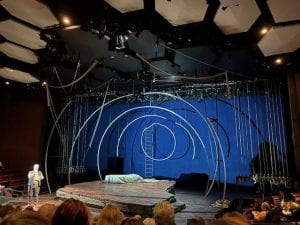To fast from strife,
from old debate
and hate;
to circumcise thy life.
(Robert Herrick,”To Keep a True Lent” )
I was surprised that Robert Herrick knew so much about our current political circumstances. How we rant and rave about issues we cannot change. Is it possible his era had some of the same provocations? Misery loves company. Thank you, Mr. Herrick.
I realize I am not alone in the cause of changing society, especially politics. I think we writers are delusional about the impact we have on human behavior, so we should all take a break and “circumcise” our lives.
Taking another tack, I saw an incredible theater production of Moby Dick on Thursday.
When I heard The Rep was staging a dramatic version of Moby Dick I thought, Come on, a 900-page book in a stage production? Then someone mentioned to Victoria what a great theatrical experience the play was, so we went out of curiosity.
Amazing! Herman Melville would be impressed. The adaptable set with its moving rigging and skeletal outline inside the whale,
the amazing gymnastics of climbing the rigging, the haunting music of the chorus of Fates chanting from every corner of the stage, the lunacy of Ahab, the civility of Starbuck, the purity of Queequeg, the faithful reporting of Ishmael, the narrator. It was eerie and spellbinding.
The plot revolves around Ahab and his relentless quest for revenge on the white whale Moby Dick, who severed his leg. His obsessive rage grows with every scene. First they attack a whale with a baby nearby. The crew swings down from the lofty masts, twenty feet above the stage. They lower two small platforms from the rafters that serve as smaller boats that buck and sway as they attack the whale (not visible). They land the whale and the baby, which we see dismembered on the stage; an actress is suspended upside down, her layers of clothing stripped off so we can imagine the brutality of processing a whale. Don’t worry, she kept one layer on.
In another touching scene Starbuck (First Mate) shares with Ahab his desire to return home to his family with the whale oil they have secured in barrels. Ahab surprises us by recalling a wife and child he left behind. It seems he might be persuaded to return to port, but suddenly the fit of passion seizes him and he declares his determination to find the monster Moby Dick and destroy him, just as the white whale had taken his leg.
Hoping not to spoil too much, I have to describe the final scene, where the sailors are cast overboard when Moby Dick shatters the ship. A woman emerges from the back of the stage with a blue luminescent tissue wound around her. The tissue unwinds from her until the entire stage is encompassed with blue/violet shimmering silk, with one slit from her body to the reaches of stage left. One by one the sailors enter the billowing waves through the slit. They are swept off the stage as the woman backs away with the men covered under. The only survivor is Ishmael, who clings to the coffin containing the fallen Queequeg. By floating on that coffin Ishmael is eventually rescued to tell the story.
This kind of imaginative stagecraft saturates the entire production, staged in the belly of the framing whale structure. The acting was moving, but the story was about the physical battle with the sea and the ominous singing of the three Fates, (evoking the weird sisters of MacBeth), all of which foreshadow death and defeat.
Spoke too soon, Moby Dick ends in St. Louis on February 25.
